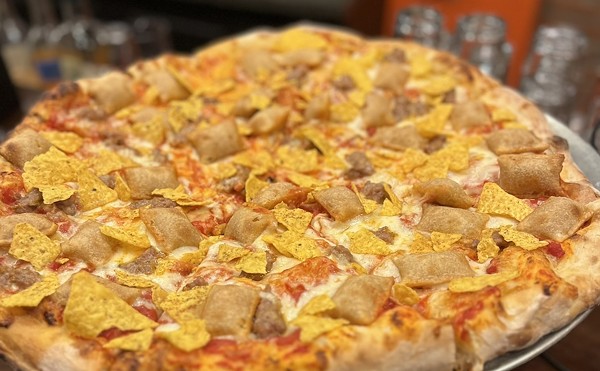Few Americans are concerned with achieving enlightenment, but we revel in the sensual pleasures of Indian cuisine. Just as in sexual pursuits, variety is the name of the game. We glory in the aroma of Kashmiri saffron, delight in the pungency of Goan vindaloo, luxuriate in the silkiness of Bengali coconut milk. More affluent, mobile Indians from Punjab, in the northwest, have popularized the tandoori cooking style in India and brought it to the rest of the world. This region's food is disproportionately represented in American restaurants such as the new Tandoori Hut. Its owner, Jas Uppal, is from Punjab, and Uppal's nephew, Sunny Nath, is the chef.
The dishes on Tandoori Hut's menu are similar to those offered in other Indian restaurants. What distinguishes Tandoori Hut's food, Uppal says, is its freshness and healthfulness. He rejects produce deliveries if the vegetables do not meet his standards. Meats are cut by hand, and all visible fat is trimmed away. In addition, Nath prepares every dish to order. And how is the food spiced? "Ah, that is the art and experience of the chef," Uppal replies solemnly. "Of course," he adds quickly, "it is also spiced according to the customer's taste -- hot, medium or just mild."
Each section of the restaurant's menu is divided into vegetarian and nonvegetarian items. Because meatless meals are so commonplace in India, we sampled several vegetarian dishes. Among the appetizers, dahi vada, or black-lentil patties, were dry and crumbly despite their veil of yogurt sauce, which had the cool, palate-cleansing quality of raita. We were also disappointed with the vegetable samosa, pastry packets filled with peas, onions and potatoes. The oil seeping through the doughy shells had a strangely chemical odor and taste.
We fared much better among the vegetarian entrées. Punjabi paneer is a pungent stew of tomatoes, green bell peppers, onions, scallions, spices and cubes of house-made cheese. Often referred to as Indian cream cheese or cottage cheese, this agreeably bland dairy product has the springy, porous texture of firm tofu. Navratan korma, misleadingly billed on the menu as "mixed vegetables, cheese and dried fruit in cream sauce," seemed to lack both the cheese and the dried fruit. The so-called cream sauce could more accurately be described as a topaz-tinted gravy. Nevertheless, we loved the complex flavors, evocative spices and contrasting textures in the dish. The basmati rice presented with these entrées was infused with the fragrance of brittle cinnamon sticks and ridged, almond-shaped cardamom pods.
If you care to have bread with your meal, you must order it. On our first visit, we ate badami naan, a floury pocket bread with sliced almonds and poppy seeds tucked inside. On another evening we munched onion kulcha, a porous round of leavened whole-wheat bread studded with chopped red onions. The restaurant follows the Indian custom of serving all the savory dishes at once, so be sure to tell your waiter if you'd like your bread or appetizers brought before the entrées.
We ordered several nonvegetarian dishes as well. My meat-and-potatoes dining partner began one meal with chicken pakora, which he labeled "chicken fingers" -- slices of white meat deep-fried in a chickpea batter. Tiny silver flasks of mint chutney and tamarind sauce accompanied the appetizer. However, the sauce was missing the sour tang characteristic of tamarind pulp. It reminded us of thin, cloying pancake syrup.
In keeping with the restaurant's name, part of the menu is devoted to dishes baked in the withering 500-degree heat of a tandoor, a kilnlike clay oven. We couldn't detect the spiced-yogurt marinade on the tandoori tiger prawns, but the shellfish were large, fresh and expertly cooked. The obligatory curry dish we chose was made with scallop-size chunks of chicken breast. A chilled mango lassi, a frothy yogurt drink, tempered the heat of the chiles in the perfumed sauce, an amalgam of ginger, garlic, turmeric, cumin and other herbs and spices.
The name Tandoori Hut is both a reflection of the restaurant's cuisine and a tongue-in-cheek reference to the building's unmistakable Pizza Hut architecture. The owners have attempted to conceal the restaurant's lineage by painting the exterior and whitewashing the interior trim. They've draped white tulle across the plate-glass windows, placed crystal flower vases on each sill and spread white linen cloths on the tables. The effect is surprisingly bright and pleasant. Still, the boxy room retains many of its original features, right down to the sneeze guard on the old salad-bar trolley. Tandoori Hut has been thronged with customers since opening day. For those wayward rajasikas in the crowd, a visit could be perilous -- a mere whiff of masala could doom them to lives of wanton hedonism. Tempting, isn't it?





